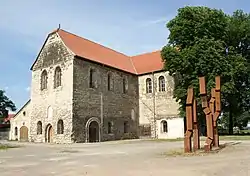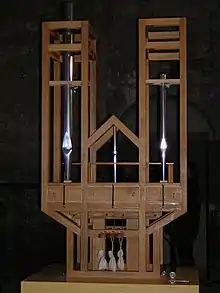
Organ2/ASLSP has been playing in Halberstadt for
22 years, 3 months, 3 weeks and 2 days
ORGAN2/ASLSP (As Slow as Possible) is a musical piece by John Cage and the subject of the second-longest-lasting musical performance yet undertaken. Cage wrote it in 1987 for organ, as an adaptation of his 1985 composition ASLSP for piano. A performance of the piano version usually lasts 20 to 70 minutes.[1]
An organ in St. Burchardi church in Halberstadt in 2001 began a performance that is due to end in 2640. The next note will be played on February 5, 2024.
History
The Friends of the Maryland Summer Institute for the Creative and Performing Arts commissioned the piece for contemporary requirement of a piano competition. Cage used an open format to ensure no two performances would be the same, and give judges a break from the consistency of most compositions. The score is eight pages.
Performances
Diane Luchese played Organ2/ASLSP from 8:45 am to 11:41 pm on February 5, 2009, at Towson University. This 14-hour-56-minute performance was the longest recorded individual performance until 2022.[2] YouTube and Twitch channel 'AllRequest_Live' performed an adapted version of ASLSP to a live audience for 24 hours, from 12:00am on February 4, 2022 to 12:00am on February 5, 2022.[3] Stephen Whittington performed an 8-hour version of ASLSP on the Elder Hall organ for John Cage Day in 2012 at the University of Adelaide.[4][5][6][7] Organists Patrick Wedd, Adrian Foster, and Alex Ross gave a 12-hour team performance at Christ Church Cathedral, Montreal, in 2015. Daniel Cooper gave a 12-hour performance in Knox Church to mark the Southern Hemisphere's winter solstice in 2019.[8] Christopher Anderson gave a 16-hour performance, currently the second slowest performance and longest complete performance on record, on March 8, 2022 at Perkins Chapel on the campus of Southern Methodist University.
Halberstadt performance


Background
Musicians and philosophers discussed Cage's instruction to play "as slow as possible" at a conference in 1997, because a properly maintained pipe organ could sound indefinitely. The John Cage Organ Foundation Halberstadt decided to play the piece for 639 years, to mark the time between the first documented permanent organ installation in Halberstadt Cathedral, in 1361, and the originally proposed start date of 2000. Because of a lack of money, the date was postponed by one year.[9] The chord changes of the first part which ends in 2072 were calculated by Christoph Bossert and Rainer O. Neugebauer. Until August 2021 the Foundation sold plaques commemorating the years through 2640 to fund the performance.[10][11]
The instrument
An organ was built specifically for the performance.[12] It is in the church's right transept, with the bellows in the left transept.
Until 2011 Acrylic glass encased it to reduce the volume.[13]
Performance
The Halberstadt performance started on September 5, 2001, with a rest lasting until February 5, 2003, when the first pipes played.[14][15] Sandbags depress the organ's pedals to maintain the notes.[1] On July 5, 2008 two more organ pipes were added alongside the four already installed and the tone became more complex at 15:33 local time. The bellows provide a constant supply of air to keep the pipes playing.[16] On July 5, 2012 two more organ pipes were taken out, and two were in the organ. The note last changed on February 5, 2022. The performance is scheduled to end on September 4, 2640.
|
|
See also
- AS Long as Possible, a GIF-based visual art work named in tribute to As Slow as Possible
- List of compositions by John Cage
- Longplayer
References
- 1 2 Rosenberg, Steve (2008-07-05). "'World's longest concert' resumes". Retrieved 2023-09-05.
- ↑ "The Towerlight, Fifteen hours at the organ". Media.www.thetowerlight.com. Archived from the original on 2009-02-10. Retrieved 2011-08-30.
- ↑ "AllRequest: As Slow As Possible 24 Hour Performance". YouTube. Retrieved 2022-02-28.
- ↑ "Stephen Whittington: Musical Renewal". RealTime. Retrieved 2012-09-27.
- ↑ "News and Events". J.M. Coetzee Centre for Creative Practice. Retrieved 2012-09-27.
- ↑ "John Cage Day, Wednesday 5th September 2012". YouTube. Archived from the original on 2021-12-13. Retrieved 2012-09-27.
- ↑ "John Cage Day Celebrated in Adelaide with Free Concert in Elder Hall". Herald Sun Newspaper. Retrieved 2012-09-27.
- ↑ "John Cage: Organ2 / ASLSP". Music Canterburyn. 2019-06-14. Retrieved 2019-07-07.
- ↑ "First notes for 639-year composition". 2003-02-05. Retrieved 2023-09-05.
- ↑ Gonsher, Aaron. "A Visit to John Cage's 639-Year Organ Composition". redbullmusicacademy.com.
- ↑ "Alle Stiftertafeln sind vergeben". Archived from the original on 2023-05-22. Retrieved 2023-07-22.
- ↑ "Sankt Burchardi Church Organ". atlasobscura.com. Retrieved 2018-12-20.
- ↑ Archived at Ghostarchive and the Wayback Machine: "5 Min 48 sek von 639 Jahren: JOHN CAGE ORGAN 2 / ASLSP IN HALBERSTADT". YouTube.
- ↑ "News - John-Cage-Orgelprojekt Halberstadt". www.aslsp.org. Archived from the original on 2021-09-07. Retrieved 2019-12-08.
- ↑ "the Halberstadt event website". John-cage.halberstadt.de. 2004-11-19. Archived from the original on 2011-07-22. Retrieved 2011-08-30.
- ↑ "One Thousand Hear Change of Note in World's Longest Concert". Deutsche Welle. Deutsche Presse-Agentur. 2008-07-05. Retrieved 2011-08-30.
- ↑ "Klangwechsel - John-Cage-Orgelprojekt Halberstadt". www.aslsp.org. Archived from the original on 2021-09-10. Retrieved 2019-12-08.
External links
- Website of the Halberstadt event (in German)
- As Slow As Possible, Performance Today feature (National Public Radio), September 2003
- Recordings of a nine-hour performance of ASLSP at ARTSaha! 2006 by Joseph Drew: Hour One, Hour Six, Hour Nine
- Die eingefrorene Zeit, Die Zeit, January 8, 2006 (in German)
- (JC{639}) Documentary Film by Sabine Groschup, 2006/20012
- Website of the documentary film ASAP by Scott Smith
- "World's longest concert will last 639 years" The Washington Post. November 21, 2011.
- A Visit to John Cage's 639-Year Organ Composition von Aaron Gonsher, Red Bull Music Academy, April 12, 2019
- The Longest Song, Newstalk Radio Dublin, The Sean Moncrieff Show, September 11, 2020
- Meet John Cage, the Innovative Composer Behind the 639-year-long Consert, HowStuffWorks, October 27, 2020
- Cage Conversation with Richard T. Eldridge, NAMM Show Believe in Music Week, January 2021
- How Slow Is Slow?, FutureStops. A project of the Royal Canadian College of Organists Podcast Episode 02, September 23, 2021
- “I think what we need in the field of music is a very long performance …”, Lecture at the Internationalen JAMA Symposium '75. ročník Milana Adamčiaka' in Baňská Štiavnica (Slovakia), October 23, 2021
- The John Cage Organ Project & the Climate Change, Interview with Warren Senders, Music 4 Climate Justice at 2021 United Nations Climate Change Conference in Glasgow November 12, 2021
- The longest, slowest organ music ever, Interview with Bianca Hillier, The World (radio program), January 4, 2023